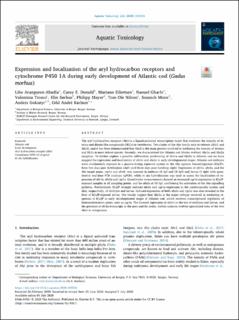| dc.description.abstract | The aryl hydrocarbon receptor (Ahr) is a ligand-activated transcription factor that mediates the toxicity of dioxins and dioxin-like compounds (DLCs) in vertebrates. Two clades of the Ahr family exist in teleosts (Ahr1 and Ahr2), and it has been demonstrated that Ahr2 is the main protein involved in mediating the toxicity of dioxins and DLCs in most teleost species. Recently, we characterized the Atlantic cod (Gadus morhua) Ahr1a and Ahr2a receptors. To further explore a possible subfunction partitioning of Ahr1a and Ahr2a in Atlantic cod we have mapped the expression and localization of ahr1a and ahr2a in early developmental stages. Atlantic cod embryos were continuously exposed in a passive-dosing exposure system to the Ahr agonist, benzo[a]pyrene (B[a]P), from five days post fertilization (dpf) until three days post hatching (dph). Expression of ahr1a, ahr2a, and the Ahr-target genes, cyp1a and ahrrb, was assessed in embryos (8 dpf and 10 dpf) and larvae (3 dph) with quantitative real-time PCR analyses (qPCR), while in situ hybridization was used to assess the localization of expression of ahr1a, ahr2a and cyp1a. Quantitative measurements showed an increased cyp1a expression in B[a]P-exposed samples at all sampling points, and for ahr2a at 10 dpf, confirming the activation of the Ahr-signalling pathway. Furthermore, B[a]P strongly induced ahr2a and cyp1a expression in the cardiovascular system and skin, respectively, of embryos and larvae. Induced expression of both ahr2a and cyp1a was also revealed in the liver of B[a]P-exposed larvae. Our results suggest that Ahr2a is the major subtype involved in mediating responses to B[a]P in early developmental stages of Atlantic cod, which involves transcriptional regulation of biotransformation genes, such as cyp1a. The focused expression of ahr1a in the eye of embryos and larvae, and the presence of ahr2a transcripts in the jaws and fin nodes, further indicate evolved specialized roles of the two Ahrs in ontogenesis. | en_US |
